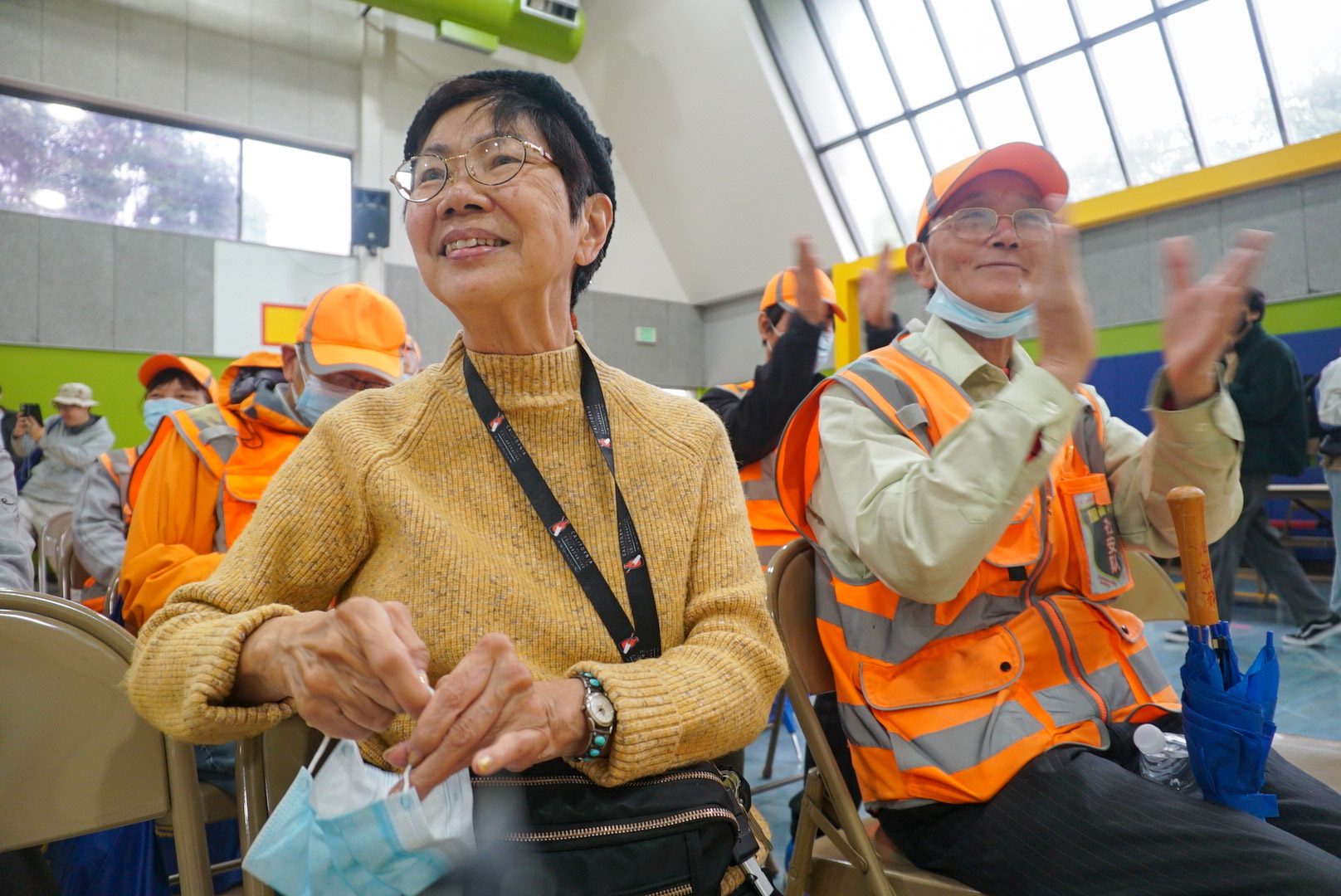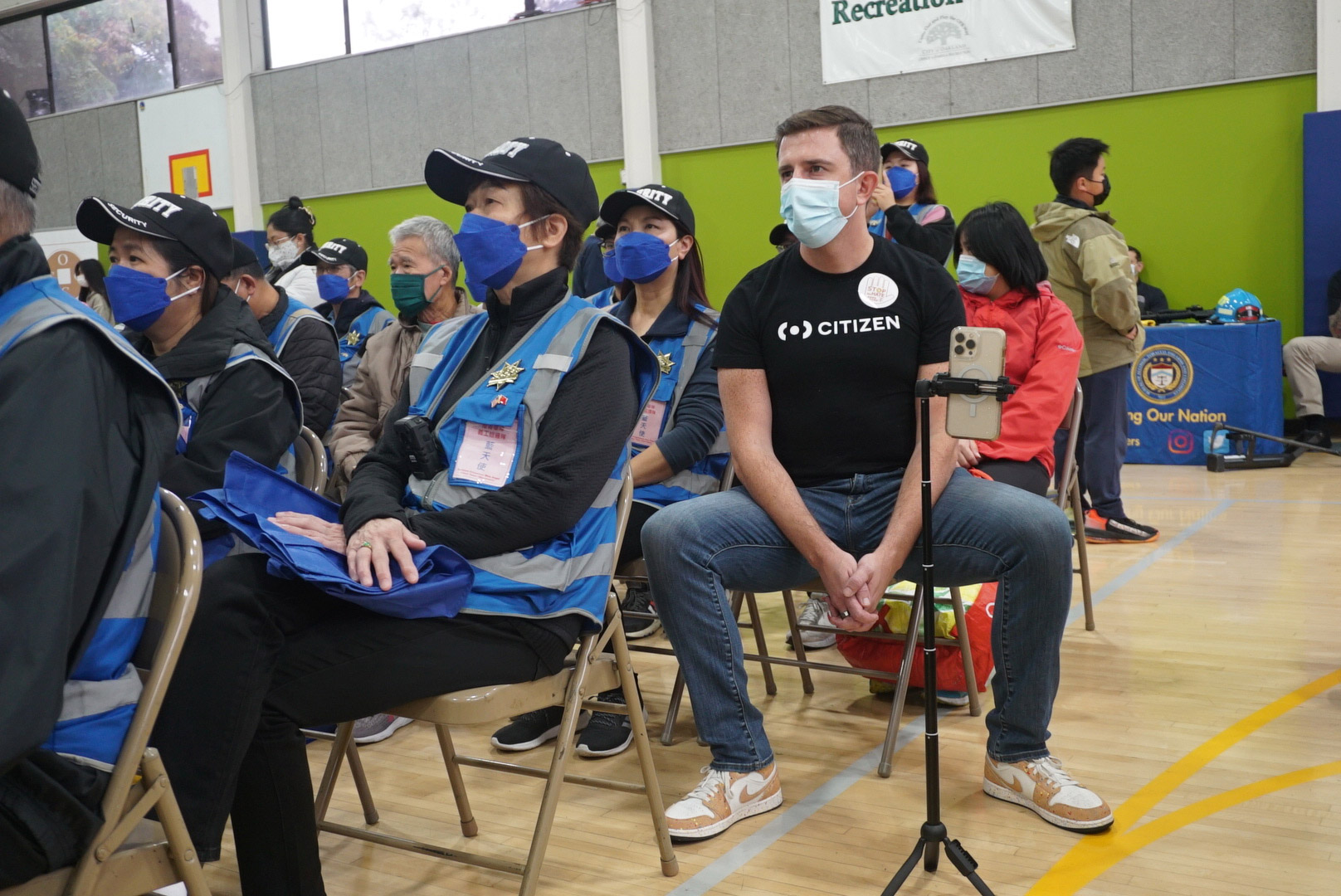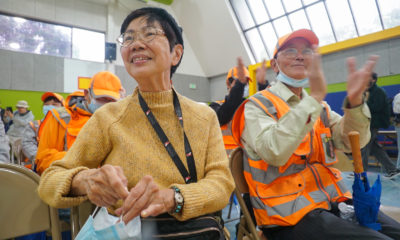Tech
Citizen如何通过招募亚裔老年人来重塑自己
Published
1 year agoon
By
Drew Simpson
Editor’s note: This is a translation of a story about how the crime-tracking app Citizen has been giving away free subscriptions to elderly Asians in the Bay Area. Find the English language version here.
本文是与普利策中心的人工智能问责网络合作撰写的。
当外面天黑的时候,约瑟芬·赵(Josephine Zhao)哪怕只是走几个街区就能回到旧金山的家,有时也会多叫一双“眼睛”——字面意义的眼睛。
赵打开手机上的Citizen App,通过一个名为“实时监控”的功能,与该平台的一个客服人员建立联系。而该平台也可以通过网络追踪到赵的GPS位置,客服只要点击另一个按钮,就可以得到打开她手机摄像头的授权。这样该平台就可以“看到我所看到的东西”,赵说。通常来说,她甚至不会和客服人员进行对话,但她知道“这时有人和我一起走”,这会让赵感到安心一些。
这是赵最近采取的最新安全措施之一:她也避免乘坐公共交通工具,以及在城市里走路的时候,会在她的钥匙链上挂着一个长长的尖头装置。这个装置是一个浅粉色的塑料制品,必要的时候会变成一个武器。
但在她看来,Citizen这样一个允许用户报告和跟踪附近犯罪通知的超级本地应用程序是她最好的保护手段之一,这种数据驱动的DIY安全措施能够保护一个长期被忽视的群体。
“我们在教育、公共安全、住房、交通方面上的需求,都没有得到满足和关切。就好像我们不重要一样。”赵说,她目前也是多家教育非政府组织的代课教师和社区联络员,“我们的需求没有得到尊重,我们的需求没有得到满足,人们到处都轻视我们。”
“我真的相信Citizen是一个维持社会正义和种族正义的工具。”
“我们必须实施一些行动来保护我们的社群,”她补充道。“Citizen是最完美的工具。”
在当地持续发生基于种族的攻击、以及一系列针对亚裔居民的大规模枪击事件之后,许多亚裔和太平洋岛民(AAPI,Asian-American and Pacific Islander)社群的居民们都告诉《麻省理工科技评论》他们欢迎这款应用程序,认为它可以解决反亚仇恨带给他们的焦虑。
对于这些受到严重创伤的人们来说,Citizen成为了让他们获得安心的一种方式。
Citizen的转型
对于这款应用来说,这种积极的反响似乎有些奇怪。毕竟因放大了人们对犯罪的幻想,并帮助白人居民实行种族门禁,它长期以来一直都在遭受着批评的声音。Citizen最初被命名为“治安警员”,因为它有一段曲折的历史:苹果应用商店在该款应用2016年推出后的一周内就将其下架,因为它违反了苹果的《开发者审查指南》,该指南规定应用程序不得鼓励身体伤害。2021年,该公司的首席执行官要求他的员工悬赏3万美元,寻找一名他误认为在洛杉矶纵火的人,这在当时成为了头条新闻。而且该款应用的客户也经常因发表种族主义言论而受到批评。
正是在这种情况下,这款应用现在正在积极地争取像赵这样的用户。从2022年9月开始,通过社区团体如奥克兰华埠商会(Oakland Chinatown Chamber of Commerce)或者旧金山美国华商总会(Chinese American Association of Commerce in San Francisco)组织的活动,Citizen一直在湾区招募中国裔和其他亚裔居民,其中包括许多老年人,他们加入服务可以免费获得价值240美元的一年高级订阅服务。(虽然该应用程序的免费版本会向用户发送值得注意的事件警报,但要是想获得与Citizen雇员实时连线监控服务,则需要更高级的版本)。目前,赵直接与Citizen合作,帮助将其应用程序界面翻译成中文,并帮助其在她的人际圈中进行宣传。
该应用程序的最终目标,是想从该地区的AAPI社群招募2万名新用户,这可以带来相当于价值约500万美元的一年付费订阅。Citizen组织的产品负责人达雷尔·斯通(Darrell Stone)表示,目前已经有700人注册了他们的应用程序。
旧金山湾区的项目也是对应用程序更广泛改造的测试,它成功地吸引一些可能经常得不到警察保护的弱势群体,从亚特兰大的黑人跨性别社群到芝加哥地区的帮派暴力受害者。“我真的相信Citizen是一个维持社会正义和种族正义的工具,”特雷弗·钱德勒(Trevor Chandler)说,他在去年担任Citizen组织的政府事务和公共政策主管时,领导了该应用程序在旧金山湾区的试点项目。
但是,一些与湾区亚裔社群合作的倡导者,以及专注于弱势人群中的不实信息研究领域的专家,却怀疑这种快速危险预警技术是否真正解决了核心问题,即它是否真的能让人们更安全,而不仅仅是让他们感觉更安全一点。除此之外,他们还怀疑Citizen应用程序是否有时会让事情变得更糟,因为它可能会放大对这个社群的偏见,特别是在全球疫情大流行给地方和全国的亚裔社群带来无尽创伤的时候。
“几乎每天你都可以在任何社交媒体上看到该款应用程序向群众征集的信息,在整个技术生态圈中被疯狂和快速地传播,在我看来这完全是不正常的,”倡导亚裔社群的社会、政治和经济福祉的非营利组织OCA的公共事务副总裁肯德尔·小佐井(Kendall Kosai)说。
他说,他在自己的手机上安装了Citizen,并对一些用户针对某些事件提交的偏见评论而感到吃惊。“这对我们社群居民的心理到底有什么样的影响呢?”他提问道,“很明显,这一切可能很快就会失控。”
获得“正确的信息”
“我很高兴能使用它,”49岁的爱丽丝·金(Alice Kim)说,她和丈夫在旧金山北部的里士满区经营着一家名为Joe’s Ice Cream的冰淇淋店,该区域的大约三分之一人口是亚裔,金表示最近会看到各种破坏事件和汽车盗窃案件的增加。
和许多其他亚裔美国人一样,金氏夫妇觉得,对他们安全的担忧在很长一段时间里都被置若罔闻,基本上被当地政客忽视了。“感觉他们生活在另一个世界,”爱丽丝的丈夫肖恩·金(Sean Kim)说。
在2021年的几个月里,他们的商店发生了三次企图闯入事件,当爱丽丝说她要求人们不要使用卫生间时,人们甚至几次向她扔垃圾,或者开始争吵。
“每天早上我来上班的时候都会有点焦虑,我的商店有没有被盗窃,会不会又看到一扇破损的窗户,”爱丽丝告诉我,“尤其在疫情期间,我感觉非常紧张和不安全。”
2022年秋天,爱丽丝让肖恩在她的手机上安装了Citizen应用程序,他之前一直向爱丽丝说明该款应用程序的各种好处。在该应用程序开始向AAPI社群宣传前,肖恩就一直在使用Citizen应用程序,并且当他的朋友赵给他们一个免费试用的高级版本时,他果断地升级了该款应用程序。
肖恩认为Citizen比其它本地信息应用程序如NextDoor更可靠,因为他感觉到Citizen所提供的消息似乎是得到了验证。(除了依赖各种公共数据来源的紧急情况信息外,Citizen员工表示,他们还会在发布犯罪信息之前对用户报告的犯罪信息进行审查。)
“我们在尝试要求人们仔细检查微信群中所转发的信息,”因为“这些信息有时会造成其他人恐慌。”
“我认为越来越多的人使用Citizen,是因为很多人来核实这些信息。”肖恩继续解释说, “所以至少我知道,哦,那不是一声枪响。如果没有这个应用程序,我听到了一声枪响的时候,我完全不知道发生了什么事。我觉得这是一个有效的工具。我知道正确的信息,这让我感觉很安全。”
对爱丽丝来说,能够通过Citizen的高级功能与客服建立联系,可以解决一些可能没有达到真正犯罪门槛、但却让她感觉很不安全问题的一种方式。在应用程序的地图上,红点表示严重事件的报告,比如有人被车撞了或被武器袭击了;黄点表示较温和的一些预警信息,比如报告有武装人员或检测到气体气味,灰点表示值得注意但没有威胁性的问题,比如丢失的宠物。
和金一家人一样,湾区的许多亚裔居民们都积极接受监控,因为他们觉得长期以来都被忽视了。AAPI社群的居民已经在旧金山和奥克兰的华埠组织了各种自发的巡逻活动(尽管金氏夫妇还没有参与其中)。这对夫妇支持一项有争议的法案,该法案允许警方在业主允许的情况下,在24小时内调取私人监控录像。肖恩和爱丽丝还和其他小企业主谈到了安装私人监控设备的问题,附近奥克兰的华埠企业主们也采取了这一措施。对他们来说,Citizen只不过是另一个密切关注他们周围发生的事情的工具。
钱德勒认为,围绕Citizen的许多负面言论都忽略了这一观点,而且像金氏夫妇这样的一些核心用户,之所以依赖这一工具,是因为他们生活的家门口就面临着犯罪。
“Citizen和它的付费版本并不是一款万灵药,它不会解决世界上所有的问题,也不会阻止世界各地的犯罪的发生。它不是为了这些,”钱德勒说,“但这款应用程序成为了让边缘化社群表达他们的声音的一种非常强大的方式。”
“可惜的是,他们的助手里没有人会说中文”
“虽然Citizen的想法很棒。但因为我们社群的独特性,我确实带着一种善意的怀疑态度来看待这个问题,”OCA的小佐井说。“我一直在想的一件事是,它对最脆弱的成员的可及性到底是怎样的?”
他指出,美国的亚裔社群包括“50个不同的种族和100种不同的语言”,而且“不同的社区围绕这些公共安全问题,与当地执法部门进行着不同的互动。”
目前,Citizen只支持英语操作界面。奥克兰华埠商会的执行主任陈巧伦(Jessica Chen)说,要想真正有效,它必须使用中文或其他亚洲语言提供服务。(Citizen的斯通在一封电子邮件中表示,它正在“积极投资”自然语言处理技术,“将使我们能够实时地将应用程序翻译成不同的语言”,但他没有提供这些举措的细节或时间表。)
在实践层面上,当一个群体的成员对使用科技和获取信息有不同程度的熟悉度时,很难帮助他们采用同一种技术,当英语还不是他们的第一语言时就更难了。特别是对于英语非母语的老年人,从注册这个平台、到理解平台所发布的消息都是非常困难的。
“我有时间教他们吗?以及我是合适的教他们的人吗?”陈问。
75岁的约瑟芬·惠(Josephine Hui)已经在奥克兰生活了40年,她是一名金融教育工作者,经常通勤到华埠工作。最近,她和其他几位老人在一次由Citizen主办的活动上了解到这款应用程序,该活动由关注奥克兰安全问题的非营利组织亚裔犯罪委员会(Asian Committee on Crime)和奥克兰华埠商会联合举办。她在应用程序中看到了奥克兰警察局的公共安全介绍。
“我认为对于任何街上的行人来说,Citizen都是一个很棒的应用程序,”她说道,“可惜的是,他们的助手里没有人会说中文。”
不过,她说她渴望学习如何使用这款应用。她说,疫情期间她感到孤立,被困在家里,随着针对亚裔居民的攻击增多,她担心自己的安全。
但在她使用这款应用程序之前,她遇到了一个障碍:当她试图安装它时,她已经不记得自己的苹果账户密码了。
混乱的信息
作为奥克兰华埠商会的主席,陈锡澎(Carl Chan)一直在推动更多的安全措施来保护华埠的居民,并感谢社群居民的推广。
然而,对于很多老年人来说,这款App的系统语言并非他们的母语,因此陈经常要帮助他们学习怎么使用。他担心,如果信息不能被翻译成中文或越南语等语言,一些人可能会误解Citizen的警报。他还担心,如果这些老年人没有获得适当的培训,他们可能会错误地将其他地点的警报误认为是本地区的情报而传递到其他平台,这些不实信息的传播会造成不必要的恐惧。
“我们试图要求人们仔细检查微信群中所转发的信息,”陈说,因为“这些信息有时会造成其他人恐慌。”
迪尼·西特拉(Diani Citra)在美国笔会工作,专门处理亚裔社群的不实信息问题,她也担心这种有关犯罪的密集信息的传播会适得其反,使已经受到创伤的人群更加焦虑。
西特拉表示,像Citizen这样的应用程序可以帮助填补一群处于“信息荒漠”的人的信息空白,这些人可能是因为主流媒体没有关注他们,或者因为他们没有收到适合自己母语的信息。
“对许多被边缘化的社群来说,了解犯罪信息是十分有必要的,我们没有得到与我们的安全有关的社群信息。因为现在没有人提供任何信息,我们也没有资格要求他们不去别的地方获取这些信息,”她说,但使用这款应用仍然可能会产生一种“放大的危险感”。
虽然钱德勒说Citizen会不断验证其发布的信息,但亚裔居民会将从这里接收到的信息进一步传播到碎片性的新闻网站和社交平台媒体系统,如WhatsApp,微信,Viber等等。这些平台往往已经充斥着有误导性和分裂性的关于反亚仇恨的信息。
“原本是个例的事情可能会被视为是一种大趋势。”
例如,根据2022年8月一份关于亚太美国人全国委员会和虚假信息防御联盟(National Council of Asian Pacific Americans and the Disinfo Defense League)的虚假信息调查报告,越来越多的新闻聚合平台在收集犯罪者是黑人、受害者是亚裔的犯罪信息。
报告称,这些媒体有时会用更具挑衅性的标题重写新闻文章,或将旧事件当作主流媒体瞒报黑人反亚裔犯罪的证据,其目的往往是推动反黑人叙事,并将亚裔受害者的身份武器化。
报告写道:“主流媒体和新闻机构缺乏对亚裔美国人的报道,给一些单独强调其‘亲亚裔’性质的网络消息源头和平台留下了空间……这些源头助长了一些有问题的叙事,这些宣传报道围绕着女性歧视、反黑人种族主义和仇外心理进行展开。”
虽然还没有证据表明像这样的宣传信息已经在Citizen上占据上风,但西特拉说,当本来就更容易受到错误信息和分裂性叙述影响的亚裔老人看到没有背景的犯罪信息时更容易变得恐慌。 (Citizen没有回答这一系列的后续问题,包括关于该应用程序上可能出现的错误信息。)西特拉警告说:“原本是个例的事情可能会被视为是一种大趋势。”
Citizen可以改变吗?
在美国,当警察处境和治安局势已经很紧张的时候,Citizen一直在向AAPI社群示好。很多Citizen正在争取的社群都不信任警察部门或不愿与他们合作。(事实上,一些组织者告诉我,许多亚裔社群成员会避免报警来报告事件。)
“我们有时对创造一个即时的、能让情况稍微好转的解决方案感到非常兴奋,但我们对结构性的长期解决方案考虑得不够多。”
从理论上讲,对于那些通常感到被官方政府机构辜负,但仍然面临很多安全问题的人,像Citizen这样的技术可以代表一个有用的垫脚石。
不过,就在不久前,Citizen还被批评其创造了一种“恐惧文化”,鼓励人们使用私警。一名前员工曾描述该应用的主流用户是那些会写“极其种族歧视”的评论的人。
钱德勒认为,这些描述忽视了Citizen这类应用程序庞大的用户基础,这些人可能需要该应用程序提供的服务来追踪他们附近的犯罪情况,因为现实就是如此,他们的周围就是犯罪事件频发。在他看来,对于那些没有生活在安全社区的“特权”的用户来说,该应用程序可以是一个强大的信息传播工具。
举例来说,钱德勒引用了他在芝加哥的工作经历。他说,统计数据上来看,南区不如北区安全,那里的一些人每天都不得不生活在犯罪的现实之中。那里的居民告诉他,他们依靠该应用程序来确保他们的家庭安全,例如,了解是否发生了枪击或车祸,这些往往可能升级为更大的冲突。
这些芝加哥的用户“不是被 Citizen 告诉他们应该感到恐惧,”钱德勒说,“他们本来就感到恐惧。”

2022年秋冬,钱德勒一直在与湾区的政客和社区组织者进行合作,他正在与另一位当地市长和附近的组织进行交流,为他们所在地区的苗裔和越南裔社区带来Citizen的免费使用账户。在年底之前,他推动Citizen扩展到萨克拉门托县,这里的亚裔居民占比很高。
但展望未来,目前还不清楚该公司将继续向该项目投入多少资金。2023年1月初,钱德勒和其他33名员工被解雇了。
钱德勒最近发短信表示:“我很自豪能通过我们与社群伙伴的合作,不仅提高人们对AAPI社群仇恨犯罪意识,还提供切实可行的解决方案。”“我很难过,作为一名前Citizen员工,我再也不能再继续参与其中了。”
钱德勒说,该公司将坚持其承诺,为湾区的亚裔居民提供2万份免费的付费订阅服务,斯通证实,该公司“将继续推广和支持该计划”。但钱德勒也表示,他不确定是否会有其他人继续参与这个项目。
对于经常为纽约市的亚裔居民提供自卫课程的组织Soar Over Hate的主席健次·琼斯( Kenji Jones)来说,对社群的持续承诺是很重要的。他受到Citizen在湾区推广项目的鼓舞,尤其是为应用程序的用户设置一个随时待命的客服的想法“非常好”。但他也担心,免费试用服务只会持续一年,可能许多低收入的亚裔居民无法续期。
“那一年之后会发生什么呢?这是一家盈利性的公司。所以这是为了赚更多的钱。他们是在从这个群体中获利,尤其是这个群体现在感到非常危险。所以我认为,对我来说,只有一年的试用是相当不道德的,”琼斯说。
他补充道:“我们有时对创造一个即时的、能让情况稍微好转的解决方案感到非常兴奋,但我们对结构性的长期解决方案考虑得不够多。”
琼斯还指出,他的组织提供的一些最重要的课程是帮助人们树立自信,他担心使用这款应用可能会破坏这些感觉,这可能会让人们“对自己的安全更加焦虑和恐惧”。
作为亚裔人,“我认为我们中的很多人已经习惯于感到渺小,”他说,“我认为很多人需要的是信心,而这不是一款应用程序能够给你带来的。”
林·瑞·武(Lam Thuy Vo)是一名记者,她将数据分析与实地报道结合起来,以研究制度和政策如何影响个人行为。她目前也是布朗大学的信息未来研究员,普利策中心的人工智能问责研究员,以及克雷格·纽马克新闻研究生院的驻校数据记者。
感谢 MIT TR China 的张智为本文提供翻译支持。
You may like
-


The Convergence of Chat GPT, No-Code and Citizen Development
-


Forrester’s No-Code Citizen Development Security Breach Prediction Misses the Mark
-


How Citizen is trying to remake itself by recruiting elderly Asians
-


The invisible goalposts for Black female athletes
-


Paypal’s Dan Schulman: Leaders have a moral obligation to address racism
-


The new Hate Crimes Act won’t go far enough
Tech
The hunter-gatherer groups at the heart of a microbiome gold rush
Published
4 months agoon
12/19/2023By
Drew Simpson
The first step to finding out is to catalogue what microbes we might have lost. To get as close to ancient microbiomes as possible, microbiologists have begun studying multiple Indigenous groups. Two have received the most attention: the Yanomami of the Amazon rainforest and the Hadza, in northern Tanzania.
Researchers have made some startling discoveries already. A study by Sonnenburg and his colleagues, published in July, found that the gut microbiomes of the Hadza appear to include bugs that aren’t seen elsewhere—around 20% of the microbe genomes identified had not been recorded in a global catalogue of over 200,000 such genomes. The researchers found 8.4 million protein families in the guts of the 167 Hadza people they studied. Over half of them had not previously been identified in the human gut.
Plenty of other studies published in the last decade or so have helped build a picture of how the diets and lifestyles of hunter-gatherer societies influence the microbiome, and scientists have speculated on what this means for those living in more industrialized societies. But these revelations have come at a price.
A changing way of life
The Hadza people hunt wild animals and forage for fruit and honey. “We still live the ancient way of life, with arrows and old knives,” says Mangola, who works with the Olanakwe Community Fund to support education and economic projects for the Hadza. Hunters seek out food in the bush, which might include baboons, vervet monkeys, guinea fowl, kudu, porcupines, or dik-dik. Gatherers collect fruits, vegetables, and honey.
Mangola, who has met with multiple scientists over the years and participated in many research projects, has witnessed firsthand the impact of such research on his community. Much of it has been positive. But not all researchers act thoughtfully and ethically, he says, and some have exploited or harmed the community.
One enduring problem, says Mangola, is that scientists have tended to come and study the Hadza without properly explaining their research or their results. They arrive from Europe or the US, accompanied by guides, and collect feces, blood, hair, and other biological samples. Often, the people giving up these samples don’t know what they will be used for, says Mangola. Scientists get their results and publish them without returning to share them. “You tell the world [what you’ve discovered]—why can’t you come back to Tanzania to tell the Hadza?” asks Mangola. “It would bring meaning and excitement to the community,” he says.
Some scientists have talked about the Hadza as if they were living fossils, says Alyssa Crittenden, a nutritional anthropologist and biologist at the University of Nevada in Las Vegas, who has been studying and working with the Hadza for the last two decades.
The Hadza have been described as being “locked in time,” she adds, but characterizations like that don’t reflect reality. She has made many trips to Tanzania and seen for herself how life has changed. Tourists flock to the region. Roads have been built. Charities have helped the Hadza secure land rights. Mangola went abroad for his education: he has a law degree and a master’s from the Indigenous Peoples Law and Policy program at the University of Arizona.
Tech
The Download: a microbiome gold rush, and Eric Schmidt’s election misinformation plan
Published
4 months agoon
12/18/2023By
Drew Simpson
Over the last couple of decades, scientists have come to realize just how important the microbes that crawl all over us are to our health. But some believe our microbiomes are in crisis—casualties of an increasingly sanitized way of life. Disturbances in the collections of microbes we host have been associated with a whole host of diseases, ranging from arthritis to Alzheimer’s.
Some might not be completely gone, though. Scientists believe many might still be hiding inside the intestines of people who don’t live in the polluted, processed environment that most of the rest of us share. They’ve been studying the feces of people like the Yanomami, an Indigenous group in the Amazon, who appear to still have some of the microbes that other people have lost.
But there is a major catch: we don’t know whether those in hunter-gatherer societies really do have “healthier” microbiomes—and if they do, whether the benefits could be shared with others. At the same time, members of the communities being studied are concerned about the risk of what’s called biopiracy—taking natural resources from poorer countries for the benefit of wealthier ones. Read the full story.
—Jessica Hamzelou
Eric Schmidt has a 6-point plan for fighting election misinformation
—by Eric Schmidt, formerly the CEO of Google, and current cofounder of philanthropic initiative Schmidt Futures
The coming year will be one of seismic political shifts. Over 4 billion people will head to the polls in countries including the United States, Taiwan, India, and Indonesia, making 2024 the biggest election year in history.
Tech
Navigating a shifting customer-engagement landscape with generative AI
Published
4 months agoon
12/18/2023By
Drew Simpson
A strategic imperative
Generative AI’s ability to harness customer data in a highly sophisticated manner means enterprises are accelerating plans to invest in and leverage the technology’s capabilities. In a study titled “The Future of Enterprise Data & AI,” Corinium Intelligence and WNS Triange surveyed 100 global C-suite leaders and decision-makers specializing in AI, analytics, and data. Seventy-six percent of the respondents said that their organizations are already using or planning to use generative AI.
According to McKinsey, while generative AI will affect most business functions, “four of them will likely account for 75% of the total annual value it can deliver.” Among these are marketing and sales and customer operations. Yet, despite the technology’s benefits, many leaders are unsure about the right approach to take and mindful of the risks associated with large investments.
Mapping out a generative AI pathway
One of the first challenges organizations need to overcome is senior leadership alignment. “You need the necessary strategy; you need the ability to have the necessary buy-in of people,” says Ayer. “You need to make sure that you’ve got the right use case and business case for each one of them.” In other words, a clearly defined roadmap and precise business objectives are as crucial as understanding whether a process is amenable to the use of generative AI.
The implementation of a generative AI strategy can take time. According to Ayer, business leaders should maintain a realistic perspective on the duration required for formulating a strategy, conduct necessary training across various teams and functions, and identify the areas of value addition. And for any generative AI deployment to work seamlessly, the right data ecosystems must be in place.
Ayer cites WNS Triange’s collaboration with an insurer to create a claims process by leveraging generative AI. Thanks to the new technology, the insurer can immediately assess the severity of a vehicle’s damage from an accident and make a claims recommendation based on the unstructured data provided by the client. “Because this can be immediately assessed by a surveyor and they can reach a recommendation quickly, this instantly improves the insurer’s ability to satisfy their policyholders and reduce the claims processing time,” Ayer explains.
All that, however, would not be possible without data on past claims history, repair costs, transaction data, and other necessary data sets to extract clear value from generative AI analysis. “Be very clear about data sufficiency. Don’t jump into a program where eventually you realize you don’t have the necessary data,” Ayer says.
The benefits of third-party experience
Enterprises are increasingly aware that they must embrace generative AI, but knowing where to begin is another thing. “You start off wanting to make sure you don’t repeat mistakes other people have made,” says Ayer. An external provider can help organizations avoid those mistakes and leverage best practices and frameworks for testing and defining explainability and benchmarks for return on investment (ROI).
Using pre-built solutions by external partners can expedite time to market and increase a generative AI program’s value. These solutions can harness pre-built industry-specific generative AI platforms to accelerate deployment. “Generative AI programs can be extremely complicated,” Ayer points out. “There are a lot of infrastructure requirements, touch points with customers, and internal regulations. Organizations will also have to consider using pre-built solutions to accelerate speed to value. Third-party service providers bring the expertise of having an integrated approach to all these elements.”
